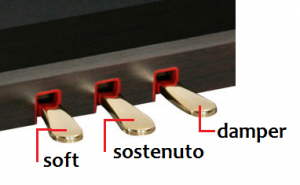Piano Pedals
Often, one of the first things I’m asked when I look at the piano with a new student is: “What are the piano pedals for?” So this article will address that question.
NAMES OF THE PEDALS
 Most pianos have 2 – 3 pedals at the base of the instrument. The one on the left is the Soft Pedal (una corda). The one on the right is called the Damper Pedal (sustain pedal). The middle pedal is called the Sostenuto Pedal. The sostenuto pedal is the one that is sometimes omitted on some instruments. Since the Sostenuto Pedal is not often used, some other piano manufacturers have given the middle pedal alternate functions. The most common alternate use is a lockable pedal that functions as a mute for quieter practice.
Most pianos have 2 – 3 pedals at the base of the instrument. The one on the left is the Soft Pedal (una corda). The one on the right is called the Damper Pedal (sustain pedal). The middle pedal is called the Sostenuto Pedal. The sostenuto pedal is the one that is sometimes omitted on some instruments. Since the Sostenuto Pedal is not often used, some other piano manufacturers have given the middle pedal alternate functions. The most common alternate use is a lockable pedal that functions as a mute for quieter practice.
THE SOFT PEDAL (UNA CORDA PEDAL)
The pedal on the left has come to be known as the soft pedal. Maybe a slight misnomer, only because invariably, as soon as the words “soft pedal” leave my mouth, the student will clamp the pedal down and slam their fingers on the keys and look accusingly at me as the strings ring out loudly. What actually happens when the soft pedal is engaged is this: on upright pianos, the hammers will move closer to the strings. The idea being that the hammers have a shorter distance to strike, so it is easier to play with a softer volume if you play gently! On a grand piano, the hammers actually move slightly to the right so that fewer strings are struck, creating a difference in volume. Less strings = less noise.
The origins of the “una corda” can be traced back to the original pianos that Bartolomeo Cristofori built where the stop was used to modify the piano’s sound. (It was originally a stop, not a pedal). Activating the stop actually moved the hammers to strike one string (una corda) instead of two (due corde). Not only was the volume affected, but also the colour and timbre of the tone.
THE SOFT PEDAL IN USE
Using the soft pedal is great when you need that added assurance that a string will actually sound when you strike the key. Nothing is worse than finishing a song with a triple ppp chord that doesn’t sound because the pianist didn’t press the keys with either 1) enough weight or 2) enough speed! Pressing down the soft pedal before quiet passages allows you to play with a little more weight and speed to make sure the notes sound but still have that quiet volume.
THE SOSTENUTO PEDAL
The middle pedal was the last to be added to the standard three pedals that you see today on modern pianos. The name is also a little bit misleading. “Sostenuto” means sustained in Italian, but the middle pedal is used to sustain only certain notes or tones that happen to be pressed down when the sostenuto pedal is engaged. In other words, when the sostenuto pedal is used, the dampers for notes that happen to be played when the pedal is down will remain in their upright position until you let go of the pedal (thereby bringing down the dampers and cutting off the sound).
THE SOSTENUTO PEDAL IN USE
Composers rarely indicate in their scores when this pedal should be used. It wasn’t until the late 1800’s that Steinway put it on their pianos. Usually in more advanced music, it would be used when you need to hold a note that would be otherwise impossible to sustain. It is likely used when a long sustained note is held with the sostenuto pedal while both hands continue to play passages around this pedal note.
THE SOSTENUTO PEDAL… OR IS IT?!
American piano manufacturers are the ones who made their pianos with sostenuto pedals for the most part. Some piano manufacturers omit the middle pedal, or even give it another use. The most common alternate use on upright pianos is having a middle pedal that functions as a mute. You can tell if your piano does this because you can slide the middle pedal to the left when depressed and a notch holds the pedal down for you. The sound is then muffled either through a felt cloth that drops down between the hammers and the strings, or by some other mechanical means. Great for practising quietly without sacrificing the feel of the key action.
THE DAMPER PEDAL OR THE SUSTAIN PEDAL
The pedal on the right raises all the dampers off the strings so that they keep vibrating after a key on the keyboard is played. This allows notes to resonate and gives the player control over connecting harmonies and notes together. When a note is struck, all the overtones also vibrate in sympathy, making a rich sound. Heinrich Gebhard’s book, The Art of Pedaling) says this about the sound of the piano:
“When the damper pedal is up (raised) the tone of the piano is cool, crisp and crystalline; when it is down (depressed) the tone is rich, sonorous and glowing.”
(p. ix, The Art of Pedaling)
Experimenting with the use of these piano pedals will add a different dimension to your playing. Proper use of these pedals will add another layer in your musical style and in your interpretation of musical works.
Return to the top of Piano Pedals.
Return to home page of the-piano-studio.com.